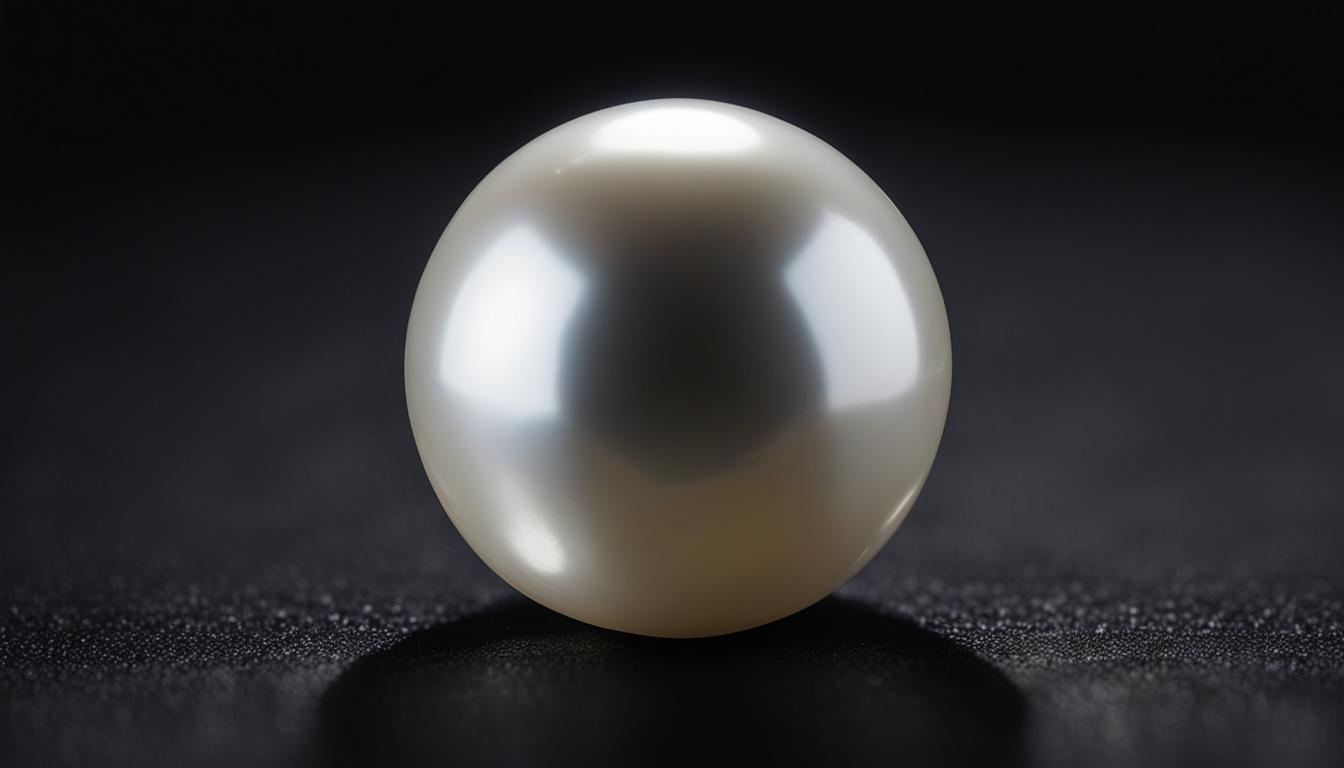Originally posted on January 1, 2024 @ 5:36 am
Pearls have been a source of fascination and intrigue for centuries. Many people believe that pearls bring bad luck or are associated with negative superstitions. However, is there any truth to these beliefs, or are they simply myth? In this article, we will delve into the origins and meanings of pearls, explore the different superstitions surrounding them, and uncover the facts behind whether pearls truly bring bad luck or if it is all just a misconception.
Key Takeaways:
- Pearls have long been associated with negative superstitions, such as bad luck.
- In this article, we will explore the origins and meanings of pearls to determine if these beliefs have any basis in reality.
- We will also examine the different superstitions surrounding pearls and uncover the facts behind them.
- Understanding the formation and symbolism of pearls will contribute to unravelling the myths and misconceptions surrounding them.
- Whether pearls truly bring bad luck or if it is all just a myth will be explored in this article.
The Meanings and Symbolism of Pearls
Pearls have a rich history of symbolism and meaning, making them more than just beautiful gems. These exquisite treasures have captivated people’s imaginations for centuries, representing various aspects of life, spirituality, and culture. Let’s explore the diverse meanings and symbolism associated with pearls.
The Spiritual Meaning of Pearls
In many spiritual traditions, pearls are seen as symbols of purity, wisdom, and enlightenment. Just as an oyster transforms an irritant into a precious gem, pearls are believed to represent the journey of the soul, overcoming obstacles and emerging stronger and wiser. Their lustrous appearance and inner glow reflect the inner beauty and divinity within each individual.
Pearls as Symbols of Wealth and Prosperity
Throughout history, pearls have been associated with wealth and prosperity. Their rarity and beauty made them highly sought after, and they became a symbol of luxury and elegance. In ancient times, pearls were often worn by royalty and the elite to showcase their status and power. Today, pearls continue to be a mark of sophistication and success.
Pearls as Symbols of Love and Devotion
Pearls have long been cherished as symbols of love and devotion. Their delicate beauty and timeless elegance make them a popular choice for wedding jewelry. Pearls are believed to enhance the bond between partners and foster harmonious relationships, making them a meaningful gift for anniversaries and special occasions.
The Symbolism of Different Types of Pearls
There are several types of pearls, each with its unique characteristics and symbolic meanings.
| Type of Pearl | Meaning |
|---|---|
| White Pearls | Purity, innocence, new beginnings |
| Black Pearls | Transformation, power, wealth |
| Akoya Pearls | Grace, elegance, sophistication |
| Tahitian Pearls | Mystery, beauty, protection |
| South Sea Pearls | Luxury, exclusivity, opulence |
These are just a few examples of the many types of pearls and their associated meanings. Each pearl carries its unique energy and symbolism, allowing individuals to connect with the qualities they resonate with the most.
Whether worn as jewelry or kept as cherished treasures, pearls continue to fascinate and inspire. Their enduring beauty and profound symbolism make them a beloved symbol throughout history and cultures.
The Formation of Pearls

Pearls, those exquisite gems that have captivated our imagination for centuries, have a fascinating and intricate formation process. To understand how pearls are formed, we must delve into the fascinating relationship between pearls and oysters.
When an oyster encounters an irritant, such as a grain of sand or a parasite, it initiates a natural defense mechanism to protect itself. The oyster secretes layers of a substance called nacre around the irritant, forming a smooth, lustrous coating. Over time, layer upon layer of nacre is deposited, resulting in the formation of a pearl.
This process of pearl formation can take several years as the oyster slowly constructs the layers of nacre, creating a mesmerizing gem that reflects light in a unique way. Each layer of nacre contributes to the pearl’s iridescence and luster, giving it its captivating beauty.
It’s important to distinguish between natural pearls and cultured pearls. Natural pearls are formed completely by chance, without any human intervention. They are rare and highly valued, as they occur spontaneously in the wild. On the other hand, cultured pearls are created through a carefully controlled process. Pearl farmers insert an irritant, such as a bead or a piece of mantle tissue, into the oyster to stimulate pearl production. The oyster then follows its natural formation process, resulting in a cultured pearl.
The Intricate Dance Between Oysters and Pearls
Oysters are the primary source of pearls, and their symbiotic relationship with pearls is truly remarkable. Oysters, known for their ability to thrive in marine environments, play a vital role in maintaining ecological balance in oceans. At the same time, they provide us with the magnificent gift of pearls, woven from the depths of the sea.
Natural Pearls vs Cultured Pearls
While natural pearls and cultured pearls go through the same formation process, their origin and value differ. Natural pearls, shaped solely by nature’s hand, are unique and extremely rare. Their scarcity makes them highly sought after by collectors and enthusiasts.
Cultured pearls, although not as rare as natural pearls, have their own allure and charm. Cultured pearls offer a more accessible option for acquiring these stunning gems, making them popular choices for jewelry and fashion.
With a deeper understanding of the formation of pearls, we can appreciate the intricate beauty of these treasures from the depths of the ocean. The dance between oysters and pearls reveals a captivating natural process that continues to mesmerize and inspire us.
The Spiritual and Mythical Associations of Pearls
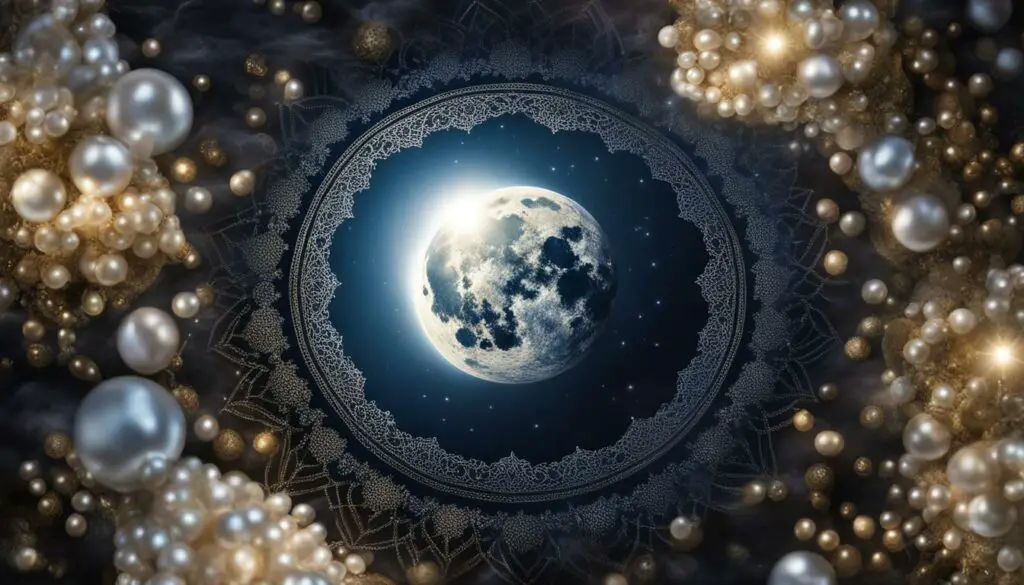
Pearls have held significant spiritual and mythical significance throughout history. In ancient cultures, they were revered for their mystical properties and believed to possess healing powers. Many cultures also associated pearls with love, harmony, and connection to higher realms.
The moon, often associated with pearls due to its watery nature, is believed to impart its energy upon these radiant gems. Pearls are thought to embody the essence of the moon, symbolizing purity, illumination, and feminine energy.
In mythology, pearls are often depicted as precious treasures bestowed by the gods. They hold sacred meaning and are a representation of divine beauty and wisdom. Pearls are mentioned in ancient texts and tales, further cementing their mythical and spiritual significance.
One notable pearl myth comes from Chinese folklore, where it is believed that pearls are formed from the tears of mermaids and hold the power to grant wishes and bring good fortune.
“The pearls shimmered like drops of moonlight, bestowing blessings upon those who possessed them.”
Pearls and Love
- Pearls have long been symbols of love and romance. In ancient Greece, they were associated with the goddess of love, Aphrodite, and were thought to inspire feelings of passion and desire.
- During the Renaissance era, pearls became popular wedding gifts, symbolizing purity and eternal love.
- In modern times, pearls continue to be worn as a symbol of love and affection, often adorning engagement rings and anniversary jewelry.
Pearls in Ancient Cultures
Throughout various ancient cultures, pearls held immense significance:
- Egyptians considered pearls to be powerful symbols of protection and used them in jewelry worn by pharaohs.
- Ancient Romans valued pearls as symbols of wealth and social status. They believed that pearls could ensure marital bliss and prevent calamity.
- In Hindu mythology, pearls were associated with moon deities and considered sacred gems with divine energy.
The Powers of Pearls
Belief in the mystical powers of pearls has transcended time and cultures:
| Pearl Powers | Belief |
|---|---|
| Healing | Pearls were believed to possess healing properties, especially for digestive issues and skin ailments. |
| Protection | Pearls were thought to protect the wearer from negative energies, evil spirits, and harm. |
| Balance | Pearls were believed to bring emotional balance, calming the mind and soothing feelings of anxiety and stress. |
| Wisdom | Pearls were associated with wisdom and enlightenment, considered to enhance mental clarity and spiritual insight. |
Intriguingly beautiful and steeped in spirituality, pearls continue to captivate our imagination with their mythical allure and symbolic power.
Pearls as Symbols of Wealth and Status

Throughout history, pearls have been highly prized and associated with wealth and status. These exquisite gems have long been a symbol of luxury and exclusivity, captivating the hearts of both royalty and the elite.
What made pearls so valuable was their rarity. Natural pearls were incredibly difficult to find, making them a true treasure. Only a few fortunate individuals possessed these natural gems, further enhancing their social status and desirability.
The historical significance of pearls as symbols of wealth cannot be understated. In ancient times, owning a collection of pearls was a display of opulence and power, reserved for the highest echelons of society. The allure of pearls transcended borders and cultures, drawing fascination and envy from far and wide.
Centuries later, pearls continued to hold their place as a symbol of affluence and prestige. Royalty adorned themselves with pearls, incorporating them into crowns, necklaces, and other extravagant jewelry pieces. The elegance and luster of pearls were closely associated with the regal splendor of monarchs and the aristocracy.
“The pearls were around her neck, luminous reminders of the wealth and power she possessed.”
Even today, pearls continue to define elegance and sophistication. While their availability has increased with the introduction of cultured pearls, the association between pearls and wealth remains strong. Pearls are still a cherished gemstone, often adorning the necks and wrists of the wealthy and influential.
Affluent Pearls throughout History
| Name | Period | Significance |
|---|---|---|
| Cleopatra’s Pearl Earrings | 1st century BC | Symbol of power and beauty |
| La Peregrina Pearl | 16th century | Owned by European monarchs |
| Queen Mary’s Fringe Tiara | 20th century | Worn by British royalty |
These historical examples highlight the enduring allure and influence of pearls among the wealthy and powerful.
As symbols of wealth and status, pearls continue to hold a special place in the world of luxury and fashion. Whether worn as a statement piece or passed down through generations, pearls not only embody beauty but also serve as a tangible testament to the social standing of those who possess them.
Cultural Beliefs and Superstitions About Pearls
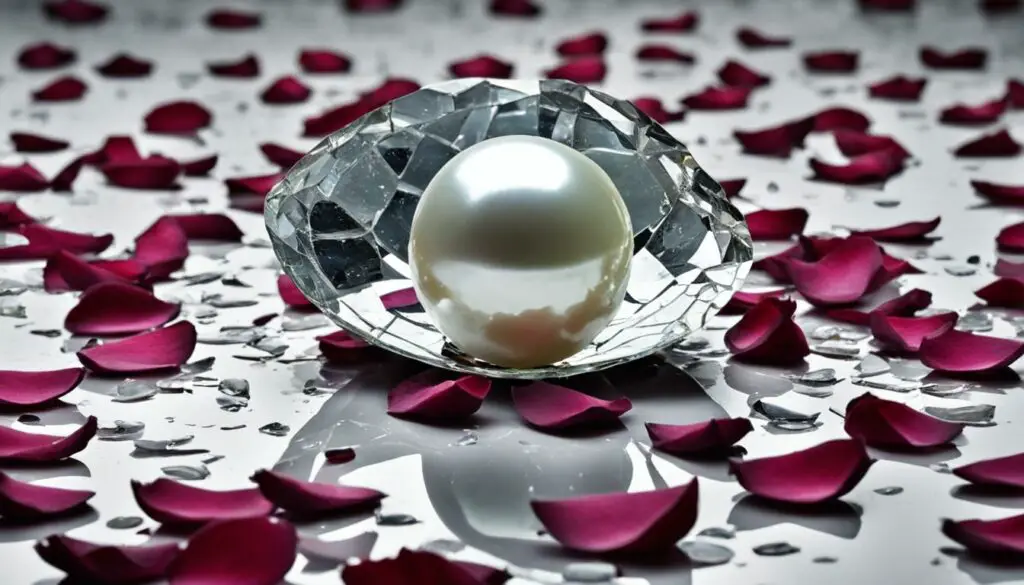
Pearls have long been surrounded by a variety of cultural beliefs and superstitions, shaping people’s perceptions of these exquisite gems. In some cultures, pearls are believed to bring bad luck and are associated with curses and even death. These superstitions have led to caution and fear when it comes to wearing pearls or keeping them in the home.
On the other hand, certain traditions and customs celebrate the positive symbolism of pearls. Take weddings, for example. Many brides wear pearls on their special day as a symbol of purity and to ward off tears. This belief reflects the idea that pearls possess protective energies and can bring happiness and joy to the marriage.
“Pearls are nature’s way of eliminating sorrow and strengthening the bonds of love. On our wedding day, pearls become our shield against tears, ensuring a lifetime of happiness and marital bliss.” – Traditional wedding saying
Despite their association with tears, pearls have also been considered a symbol of emotional healing and transformation. The belief is that pearls can help individuals overcome grief and find inner peace. This idea is rooted in the notion that pearls are formed through the healing process of an oyster, which turns an irritant into a beautiful gem.
These cultural beliefs and superstitions about pearls have shaped societies’ views of these gems for centuries. Whether seen as a source of bad luck or a symbol of protection and healing, pearls continue to hold a profound place in our collective consciousness.
Types of Pearls and Their Meanings
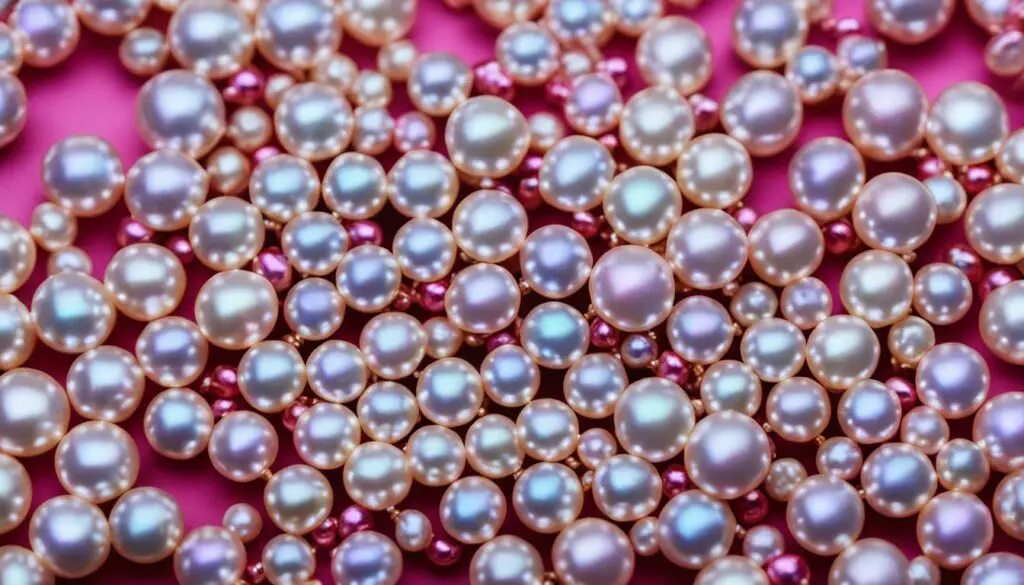
Pearls come in a variety of types, each with its unique characteristics and meanings. Let’s explore the meanings associated with different types of pearls:
1. Black Pearls
Black pearls, also known as Tahitian pearls, symbolize wealth and fertility. These exquisite pearls, with their dark hues ranging from gray to black, are highly coveted for their rarity and beauty.
2. Freshwater Pearls
Freshwater pearls are known for their natural charm and lustrous appearance. They represent purity, innocence, and new beginnings. These pearls are often irregular in shape, adding a distinctive character to jewelry designs.
3. Akoya Pearls
Akoya pearls are renowned for their elegance and classic beauty. Originating from Japan, these pearls are highly sought after for their high luster and perfectly round shape. They are associated with grace, sophistication, and timeless style.
4. Tahitian Pearls
Tahitian pearls, also referred to as “black pearls,” are prized for their exotic colors and captivating beauty. These pearls symbolize abundance, protection, and luck. The stunning range of hues, from silver to deep green, makes them a favorite among pearl aficionados.
5. South Sea Pearls
South Sea pearls, grown in the warm waters of Australia, the Philippines, and Indonesia, are celebrated for their large size and remarkable luster. These luxurious pearls represent opulence, sophistication, and status. Their creamy white and golden tones exude elegance and grandeur.
6. Baroque Pearls
Baroque pearls are unique and captivating due to their irregular shapes and asymmetrical beauty. These pearls symbolize individuality, creativity, and a free-spirited nature. The organic and artistic appeal of baroque pearls makes them a standout choice for those seeking a distinctive touch.
Each type of pearl holds its own charm and carries a particular meaning. Whether you choose a black pearl for its wealth symbolism or a freshwater pearl for its purity symbolism, pearls are a timeless and meaningful choice.
Image: Types of Pearls
Pearls in Modern Jewelry and Fashion

Pearls, with their timeless beauty and elegance, are a beloved choice in the world of jewelry and fashion. Modern designers have embraced this classic gemstone, creating innovative and stylish designs that showcase the versatility of pearls.
Pearls in Fashion: From runway shows to red carpet events, pearls have become a staple in the fashion industry. Designers are incorporating pearls into their collections in fresh and unexpected ways, capturing the attention of fashion enthusiasts worldwide. Pearls are no longer limited to traditional strands but can be found adorning clothing, accessories, and even footwear.
Pearl Jewelry: Pearl jewelry continues to be a symbol of sophistication and grace. Whether it’s a classic pearl necklace, a pair of pearl earrings, or a statement pearl ring, these pieces add a touch of elegance to any outfit. The versatility of pearls allows them to be incorporated into both traditional and contemporary designs, appealing to a wide range of personal styles.
Pearl Trends: The world of pearl jewelry is constantly evolving, with new trends emerging each season. Statement pearls are one of the latest trends, where oversized pearls are used to create bold and eye-catching pieces. Mixing and layering pearls with other gemstones or metals is also gaining popularity, adding a modern twist to the traditional pearl aesthetic.
The Timeless Beauty of Contemporary Pearl Designs
Contemporary pearl designs have redefined the way we perceive this classic gemstone. Gone are the days of simple pearl strands; today’s designs offer a fresh take on pearls, combining them with unique materials, textures, and colors.
“Pearls are the perfect complement to any outfit, adding a touch of elegance and sophistication.” – Anna Smith, Fashion Editor
Contemporary pearl designs often feature irregularly shaped pearls, known as baroque pearls. These pearls possess a mesmerizing organic beauty and are featured in necklaces, earrings, and bracelets. Their asymmetrical shapes and natural variations make each piece truly one-of-a-kind.
Another trend in contemporary pearl jewelry is the use of pearls in combination with other gemstones. This creative pairing adds vibrancy and depth to the design, enhancing the beauty and allure of both the pearls and the accompanying gemstones.
| Pearl Trend | Description |
|---|---|
| Statement Pearls | Large, bold pearls used to create attention-grabbing pieces. |
| Mixed Gemstones | Combining pearls with other gemstones for a unique and vibrant look. |
| Baroque Pearls | Irregularly shaped pearls that add an organic, eclectic touch to jewelry. |
Contemporary pearl designs have also embraced asymmetry, featuring pearls of different sizes and shapes arranged in unconventional patterns. This departure from traditional symmetrical designs adds a contemporary and artistic flair to pearl jewelry.
From delicate and feminine designs to bold and edgy statements, contemporary pearl jewelry offers something for every personal style. The versatility and enduring beauty of pearls ensure their continued presence in the ever-evolving world of fashion and design.
The Power of Resilience Symbolized by Pearls
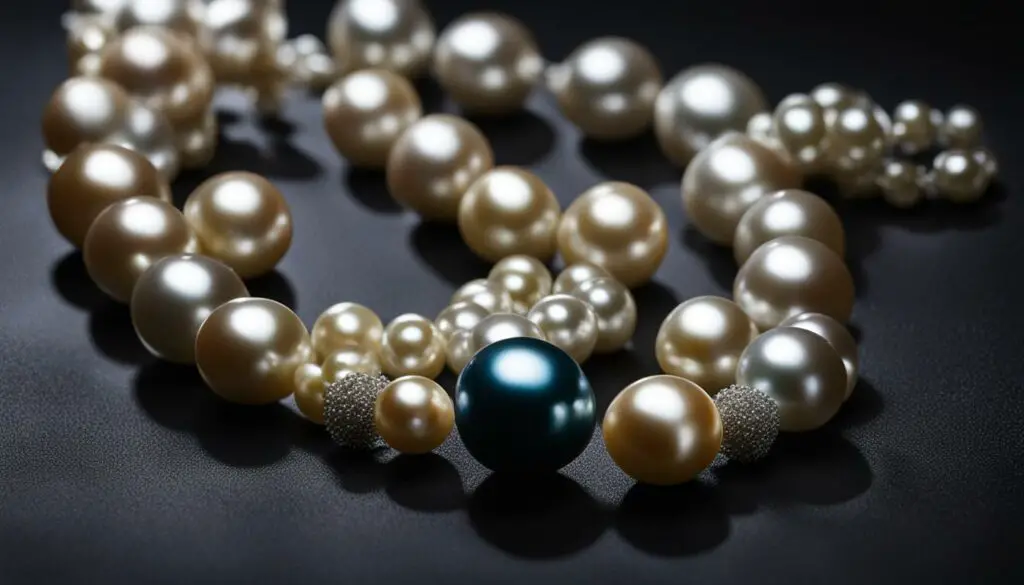
Beyond their symbolism and superstitions, pearls hold a deeper meaning as a powerful representation of resilience and personal growth. Just like the oyster transforms an irritant into a beautiful pearl, we too have the capacity to overcome challenges and transform adversity into strength.
When an irritant, such as a grain of sand, enters an oyster’s shell, it responds by coating the irritant with layers of nacre, a process that takes time and patience. Similarly, in our lives, we encounter obstacles and difficulties that may initially feel overwhelming or burdensome. However, through resilience and perseverance, we can emerge stronger and more beautiful, just like a pearl.
Pearls serve as a metaphor for our own personal transformation. They remind us that even in the face of adversity, we have the ability to turn hardships into opportunities for growth. Just as the pearl reflects light and radiates beauty, our resilience allows us to embrace our unique experiences and shine in the face of challenges.
We have within us the power to heal and transform, just like the pearl in its protective shell.
Resilience and Self-Healing
Pearls also symbolize self-healing. The process through which a pearl forms represents the oyster’s ability to repair itself and create something beautiful out of an irritant. This serves as a powerful reminder that we too have the capacity for self-healing and growth.
By harnessing our inner strength and resilience, we can confront and overcome the wounds and hardships that life presents. Just as the oyster mends and fortifies itself, we have the ability to heal our emotional and physical scars, emerging stronger and more resilient than before.
Pearls as Agents of Personal Growth
Furthermore, pearls are a symbol of personal growth. The journey of a pearl from a tiny grain of sand to a lustrous gem mirrors our own personal journeys. As we navigate the highs and lows of life, we learn valuable lessons, gain wisdom, and evolve into the best versions of ourselves.
Pearls remind us that growth and transformation are ongoing processes. Each layer of nacre that coats a pearl signifies a new chapter in its formation, just as each experience and challenge we encounter shapes our personal growth. With each hurdle overcome, we become more resilient, compassionate, and wise.
Pearls: A metaphor for resilience, self-healing, and personal growth.
Pearls in Cultural Heritage and Art
Pearls have a long and illustrious history of inspiring artists and creatives throughout the ages. With their exquisite beauty and symbolic significance, pearls have become a recurring motif in various art forms, including literature, paintings, sculptures, and music. These precious gems have left an indelible mark on cultural heritage, captivating both artists and audiences with their timeless allure.
In literature, pearls often serve as powerful symbols, representing purity, wisdom, and wealth. They are used to evoke a sense of elegance and refinement, adding depth and meaning to literary works. Famous authors like William Shakespeare, Jane Austen, and F. Scott Fitzgerald have incorporated pearls into their stories, infusing them with poetic symbolism and emotional resonance.
“The world is your oyster. The pearl is the oyster’s autobiography.” – Federico Fellini
In the world of visual arts, pearls have been depicted in paintings and sculptures as objects of desire and beauty. Renowned artists like Johannes Vermeer, Pierre-Auguste Renoir, and Gustav Klimt have immortalized pearls in their masterpieces, capturing their lustrous sheen and graceful elegance. These artworks not only showcase the artists’ technical skills but also reflect the enduring fascination with pearls throughout art history.
Furthermore, pearls have inspired composers and musicians to create exquisite melodies and harmonies. They are often used metaphorically in musical compositions to convey emotions of purity, serenity, and longing. Composers such as Johann Strauss II, Claude Debussy, and Richard Wagner have included pearls in their musical compositions, harnessing their evocative power to enhance the auditory experience.
Through their presence in art and culture, pearls continue to captivate audiences and evoke a sense of wonder and enchantment. They embody the timeless beauty and emotional depth that resonates across generations, bridging the gap between the past and the present. Whether portrayed in literature, paintings, sculptures, or music, pearls remain an enduring symbol of elegance, refinement, and artistic inspiration.
Conclusion
In conclusion, pearls are not just exquisite gems but also hold powerful symbolism and meaning in various cultures and beliefs. While there are superstitions and beliefs associating pearls with bad luck, the prevailing perception is that pearls represent purity, wisdom, love, and resilience.
Debunking the superstitions, pearls transcend any negative associations and continue to be cherished for their inherent beauty and significance. Whether you choose to embrace their symbolic meaning or simply appreciate their aesthetic appeal, pearls hold a special place in our hearts and minds.
As enduring symbols of purity, pearls have captivated people of different cultures throughout history. They remind us of the power of resilience, as they are formed when an oyster transforms an irritant into a treasure. Pearls serve as a reminder that even in the face of challenges, we can find strength and beauty within ourselves.
So let us celebrate the allure and timeless elegance of pearls, appreciating their symbolic depth and the joy they bring as cherished gems. From adorning jewelry to inspiring art and culture, pearls continue to enchant and inspire, leaving a lasting mark in the tapestry of our lives.
FAQ
Are pearls really considered bad luck?
The belief that pearls bring bad luck is a superstition and not based on factual evidence. While some cultures may associate pearls with negative meanings or curses, the majority view pearls as symbols of purity, wisdom, love, and resilience.
What are some common superstitions about pearls?
Some superstitions include the belief that pearls bring bad luck or are associated with curses and death. Other customs involve wearing pearls on wedding days to ward off tears. These beliefs vary across cultures and traditions.
Do pearls have any specific meanings or symbolism?
Yes, pearls have diverse meanings and symbolism. They are often associated with purity, balance, wisdom, and wealth. Different types of pearls, such as black pearls, freshwater pearls, and baroque pearls, have their own unique characteristics and meanings.
How are pearls formed?
Pearls are formed when an irritant, such as a grain of sand, enters an oyster’s shell. The oyster reacts by coating the irritant with layers of nacre, a substance that eventually forms a pearl. Natural pearls occur without human intervention, while cultured pearls are created through a process that involves inserting an irritant into an oyster to stimulate pearl production.
What are the spiritual and mythical associations of pearls?
Pearls have long been associated with spirituality and mythology. They are believed to possess healing powers, promote love and harmony, and connect the wearer to higher realms. The moon, often linked to pearls, is believed to embody the essence of their energy.
How have pearls been associated with wealth and status?
Pearls have historically been symbols of wealth and exclusivity. Natural pearls were extremely rare and only accessible to royalty and the elite. Their scarcity and beauty made them highly prized and associated with luxury.
What are the different types of pearls and their meanings?
There are various types of pearls, each with its own unique characteristics and meanings. For example, black pearls are associated with wealth and fertility, while freshwater pearls symbolize purity and innocence. Other types include Akoya pearls, Tahitian pearls, South Sea pearls, and baroque pearls.
How do pearls feature in modern jewelry and fashion?
Pearls continue to be highly sought after in the world of jewelry and fashion. Modern designers incorporate pearls into innovative and stylish designs that showcase their timeless beauty. Pearls add sophistication and elegance to any ensemble.
What is the symbolism of pearls as symbols of resilience?
Pearls are often seen as symbols of resilience and personal growth. The process of pearl formation, where an oyster transforms an irritant into something beautiful, serves as a metaphor for overcoming challenges and transforming adversity into strength.
How have pearls influenced art, literature, and music?
Pearls have long captivated artists and creatives, inspiring works of art, literature, and music. From literary references and famous paintings to sculptures and musical compositions, pearls have left their mark on cultural heritage through their timeless allure and poetic symbolism.
